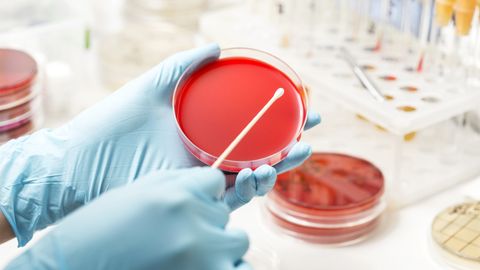World’s First Chimeric Monkey Born Using Embryonic Stem Cells
A monkey has been born that possesses a high contribution of cells derived from stem cell lines.

Complete the form below to unlock access to ALL audio articles.
Chinese scientists report the first birth of a live chimeric monkey whose cells largely derive from a line of monkey stem cells.
“This is a long-sought goal in the field,” says Dr. Zhen Liu, head of the Laboratory of Reproductive Engineering in Primates at the Chinese Academy of Sciences (CAS), and senior author of the paper.
“This research not only has implications for understanding naive pluripotency in other primates, including humans, but it also has relevant practical implications for genetic engineering and species conservation,” he adds.
Their findings are published in Cell.
Poor chimerism in nonhuman primates
The inner cell mass (ICM) of a developing embryo contains cells with the potential to give rise to various cell types that comprise the tissues found in an organism.
This type of cell potency is termed pluripotency, and over recent decades scientists have discovered ways to recreate it in vitro using either embryonic stem cells (ESCs) or induced pluripotent stem cells (iPSCs).
The “gold standard” of naïve pluripotency that occurs in the ICM is the creation of live chimeric animals. This has been achieved in rodents, but not in nonhuman primates (NHPs). “Whereas such naive pluripotency has been well demonstrated in rodents, poor chimerism has been achieved in other species including NHPs due to the inability of the donor cells to match the developmental state of the host embryos,” the authors explain.
What is a chimera?
A chimeric organism (or chimera) contains two or more populations of genetically distinct cells.
While some studies have attempted to generate chimeric monkeys using PSCs, the fetus has often had to be aborted, or possessed low donor cell contributions. One proposed idea to overcome this issue is manipulating the cell culture conditions.
The ingredients of a cell culture are critical for maintaining the viability of cells. Scientists can manipulate the concentrations of certain ingredients, such as substrates and growth factors, to influence the cells’ development.
Liu and colleagues’ study aimed to test the effects of different human PSC mediums for establishing monkey naïve embryonic stem cells and refine the technique for culturing chimeric embryos.
“Recipes that induce higher expression of naive pluripotency genes are known to display lower global DNA-methylation levels, resulting in genomic instability and karyotype abnormalities,” they write. One of the mediums tested was called 4CL, which had shown favorable outcomes in a 2022 study using human stem cells.
First live birth of a chimeric monkey
Liu and colleagues’ work utilized cynomolgus monkeys, a NHP commonly adopted in laboratory experiments. They generated nine stem cell lines by taking cells from a 7-day-old embryo, which were then cultured in different mediums. “We found that 4CL [medium] produces an improved monkey naive pluripotent state for the survival of monkey donor PSCs inside homologous blastocysts,” the researchers describe.
A selection of the cultured stem cells was injected into monkey embryos aged 4–5 days old and implanted into female monkeys. Twelve of the monkeys became pregnant, and six had live births.
By labeling the injected cells with green fluorescent protein (GFP), the researchers could detect which of the offspring possessed cells that had grown from the stem cells. One aborted male and one live-birth male possessed such cells and were therefore chimeric.
The GFP – coupled with transcriptome analysis – also enabled Liu et al to assess which tissues in the chimeric monkey contained cells derived from the injected stem cells.
The heart, brain, kidney, liver and GI tract tested positive for stem-cell-derived cells in the live monkey, and an average of 67% of cells were of stem cell origin across all tissue types analyzed.
 Images showing the green fluorescence signals in different body parts of the live-birth chimeric monkey at the age of three days. Credit: Cell/Cao et al.
Images showing the green fluorescence signals in different body parts of the live-birth chimeric monkey at the age of three days. Credit: Cell/Cao et al.
“In this study, we have provided strong evidence that naive monkey pluripotent stem cells possess the capability of differentiating in vivo into all the various tissues composing a monkey body,” Dr. Miguel Esteban, senior research scientist at BGI-Research in Shenzhen, principal investigator at CAS and the study’s co-corresponding author, says. “This study deepens our understanding of the developmental potential of pluripotent stem cells in primate species.”
The team believe that their work could support the generation of novel NHPs that could be utilized in biomedical research. NHPs play a critical role here, particularly in instances when rodent models are limited, such as the study of neurological disorders and neurodegenerative diseases.
Reference: Cao J, Li W, Li J, et al. Live birth of chimeric monkey with high contribution from embryonic stem cells. Cell. 2023. doi: 10.1016/j.cell.2023.10.005
This article is a rework of a press release issued by the Chinese Academy of Sciences. Material has been edited for length and content.






